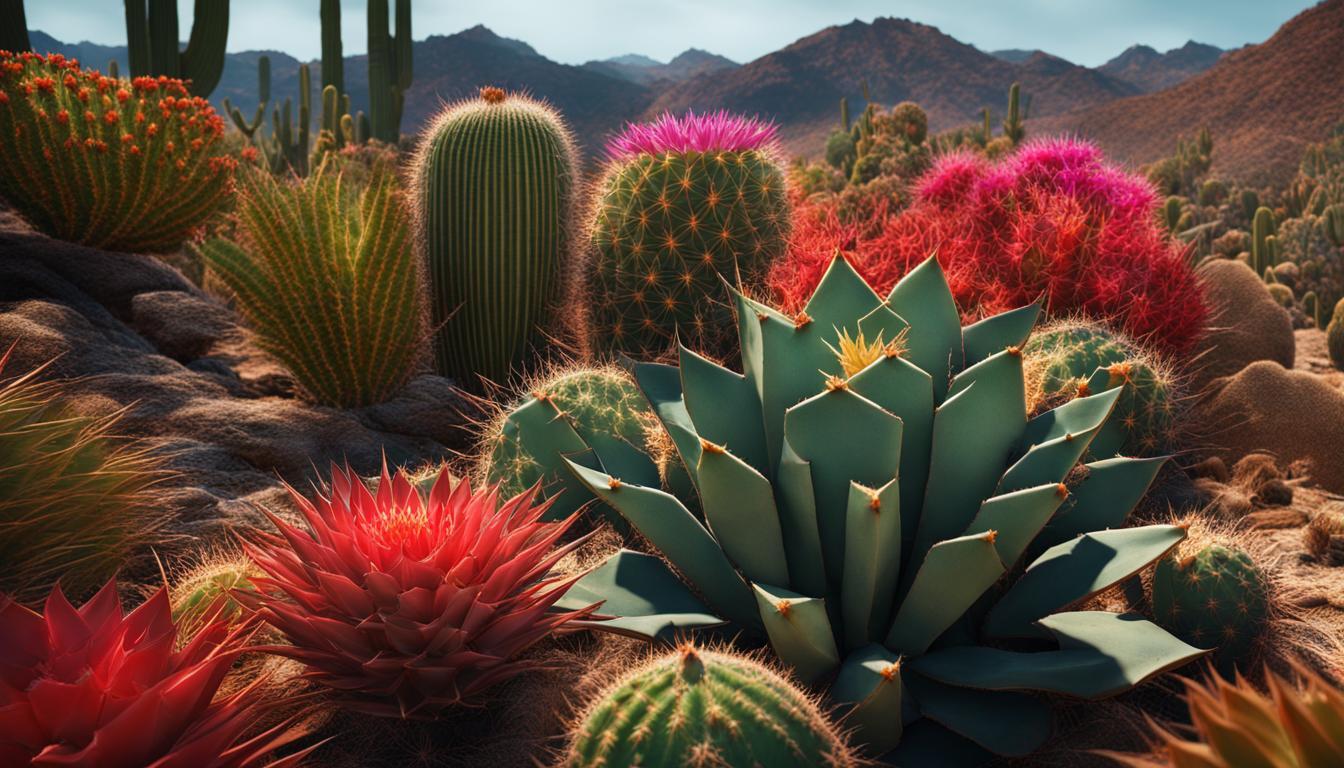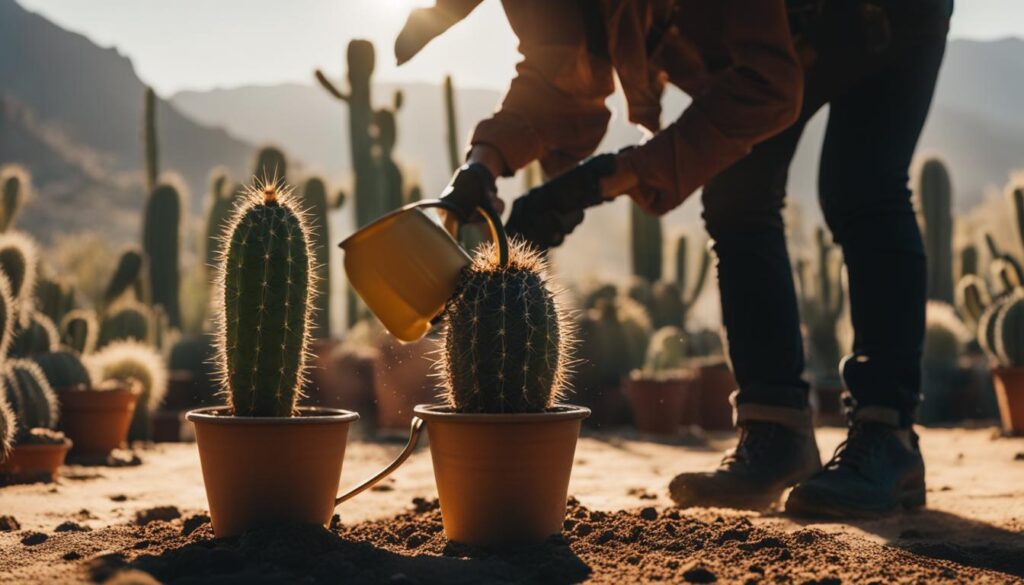
Cactus, a diverse plant with over 2,000 identified species, is not only visually appealing but also offers several benefits. Its ability to store water in its stems and leaves allows it to survive in arid environments, making it a resilient choice for both indoor and outdoor gardens.
The unique appearance of cactus makes it a favorite for creating desert-inspired landscapes and xeriscaping. Additionally, cactus has been used for centuries as a source of food and medicine. Certain cactus fruits and juice are edible and have been used to treat various ailments.
With its wide variety of shapes, sizes, and colors, cactus species can add variation and beauty to any garden. To ensure the health and longevity of cactus plants, proper care is essential. Cacti thrive in bright, direct sunlight and require well-draining soil.
They should only be watered when the soil is completely dry, as overwatering can lead to root rot. Cacti also have specific temperature requirements and prefer a warm environment. By providing the right care, cacti can thrive and contribute to the beauty and uniqueness of any space.
The Fascinating World of Cactus Species
Cactus species offer a captivating array of shapes, sizes, and colors, making them a diverse and visually appealing addition to any garden or indoor space.
From the Opuntia genus, which produces delicious cactus fruits like the prickly pear, to the unique Angel Wing cactus with its cluster of hairs instead of sharp spines, each species has its own distinct characteristics.
Some other notable cactus species include the African milk tree cactus, Christmas cactus, Ladyfinger cactus, Parodia cactus, Bishop’s Cap cactus, Rat Tail cactus, Saguaro cactus, Old lady cactus, Barrel cactus, Fairy castle cactus, Star cactus, Feather cactus, Blue columnar cactus, and Moon cactus.
With such a wide variety to choose from, cactus enthusiasts can create stunning displays featuring different shapes, textures, and colors.
Whether you prefer the towering presence of the Saguaro cactus or the delicate beauty of the Christmas cactus, each species offers its own unique charm. The diversity of cactus species ensures that there is a perfect cactus for every individual’s taste and style.
Different Cactus Species
| Cactus Species | Description |
|---|---|
| Opuntia genus | Produces edible cactus fruits like the prickly pear |
| Angel Wing cactus | Features a cluster of hairs instead of sharp spines |
| African milk tree cactus | Known for its milky sap and unique branching patterns |
| Christmas cactus | Blooms beautiful flowers during the holiday season |
| Saguaro cactus | Iconic tall cactus species native to the Sonoran Desert |
| Old lady cactus | Characterized by long white hairs that give it a fuzzy appearance |
These are just a few examples of the fascinating cactus species available. Each one offers its own allure and can be a statement piece in any garden or collection. Whether you’re a seasoned cactus enthusiast or just starting to explore the world of cacti, there is always something new and exciting to discover.
With their intriguing shapes, impressive adaptations, and striking beauty, cactus species bring a touch of the extraordinary to any environment.
From small, intricate Ladyfinger cacti to towering Saguaro cacti that stand as sentinels of the desert, the world of cacti offers a captivating and diverse range of options.
These unique plants are not only visually stunning but also resilient and hardy, making them an excellent choice for both experienced plant enthusiasts and beginners alike.
The Importance of Cactus Care
Proper care is essential for the health and longevity of cactus plants. Cacti are low-maintenance plants that thrive in bright, direct sunlight. They require well-draining soil and should only be watered when the soil is completely dry. Overwatering can lead to root rot and other issues.
Cacti also have specific temperature requirements and prefer a warm environment. Additionally, while they don’t require a lot of fertilizer, a low nitrogen fertilizer can be applied during the growing season.
Repotting should only be done when necessary, using well-draining soil and pots with drainage holes. Pruning is minimal but can involve removing dead or damaged stems.
Pests and diseases can be a concern, with common pests including mealybugs, scale insects, and spider mites. By providing the right care, cacti can thrive both indoors and outdoors, adding beauty and uniqueness to any space.
The Importance of Proper Watering
One of the most crucial aspects of cactus care is proper watering. Cacti are adapted to arid environments and can store water in their stems and leaves, allowing them to survive in dry conditions. Because of this, it’s important to avoid overwatering, as excess moisture can lead to root rot and other fungal diseases.
The watering frequency will depend on factors such as the size of the cactus, the type of pot it’s planted in, and the climate. It’s best to let the soil completely dry out between waterings, and then thoroughly water the plant until water drains out of the drainage holes in the pot. This mimics the natural rainfall patterns that cacti are accustomed to and helps prevent waterlogged soil.
Providing the Right Light and Temperature
Cacti thrive in bright, direct sunlight, so it’s important to place them in a location where they can receive at least 6 hours of sunlight a day. If grown indoors, placing them near a south-facing window is ideal.
Avoid placing them in areas with low light or excessive shade, as this can lead to elongated growth and weak stems. In terms of temperature, cacti prefer warm conditions and can tolerate high temperatures.
They also need a period of cooler temperatures in the winter to trigger blooming. It’s important to provide adequate ventilation in indoor settings to prevent stagnant air and ensure proper air circulation around the plants.
| Care Aspect | Details | Special Properties | Toxicity |
|---|---|---|---|
| Light | Bright place, avoid direct sunlight to prevent yellowing. Varies by species. | Some species like Rhipsalis need semi-shade, while others like Echeveria require bright light. | Varies by species |
| Temperature & Ventilation | Cool at night (8°C to 10°C) in autumn/winter; good ventilation in spring/summer. | Adapted to survive in arid environments; some species prefer humid conditions. | Varies by species |
| Compost | Use free-draining compost with added grit and sand for optimum drainage. | Contains the right level of nutrients for healthy growth, disease tolerance, and better flowering. | Varies by species |
| Watering & Feeding | Water at least once a week in growing season; reduce in autumn/winter. Use tepid rainwater. | Water-storing characteristics in leaves/stems. Feed once a month in growing season with specific feed. | Varies by species |
| Re-potting | Best done in spring if pot-bound. Use care to avoid damaging roots. | Proper re-potting supports healthy root growth and prevents rotting. | Varies by species |
Please note that the toxicity of a cactus plant can vary by species. It’s important to identify the specific type of cactus you have to determine if it is toxic, especially if you have pets or children. Always handle cacti with care due to their spines and potential skin irritants.
Preventing Pests and Diseases
While cacti are generally resistant to pests and diseases, they can still be susceptible to certain issues. Common pests that can affect cacti include mealybugs, scale insects, and spider mites.
These pests can be controlled by regularly inspecting the plants and removing any visible pests. In some cases, insecticidal soap or neem oil can be used to treat infestations. It’s also important to keep the plants clean and free from debris, which can attract pests and provide a breeding ground for diseases.
Avoid overwatering and provide proper air circulation to prevent the growth of fungal diseases. If any signs of pests or diseases are observed, it’s important to take immediate action to prevent further damage to the plants.

Exploring the Beauty and Benefits of Cactus
Cactus is not only visually appealing, but it also offers numerous health benefits. The cactus fruit, such as the prickly pear, is not only delicious but also packed with essential vitamins, minerals, and fiber. Consuming cactus fruit can provide a nutritional boost to your diet and support overall health.
Cactus pads, also known as nopales, are another valuable component of cactus plants. These pads are rich in fiber and can help lower cholesterol levels and regulate blood sugar levels. They are also a good source of vitamin C and possess anti-inflammatory properties, making them a great addition to a healthy diet.
When it comes to incorporating cactus into your meals, there are endless possibilities. Cactus fruit can be eaten raw, added to recipes, or transformed into refreshing beverages. As for cactus pads, they can be boiled or roasted and used in dishes like scrambled eggs, tacos, and salads. Just remember to handle cactus with care and remove the spines before preparation.
By exploring the beauty and benefits of cactus, you can enhance both your culinary experiences and your well-being. Whether you enjoy its unique taste or appreciate its nutritional value, cactus is a versatile plant that brings both flavor and health benefits to the table.
FAQ
How many species of cactus are there?
There are over 2,000 identified species of cactus.
Where is cactus native to?
Cactus is native to the Americas.
What sizes can cacti range in?
Cacti can range in size from small button-sized cacti to large tree-like cacti.
What is the most fascinating feature of cactus?
The most fascinating feature of cactus is its ability to store water in its stems and leaves, allowing it to survive in arid environments.
How has cactus been used for centuries?
Cactus has been used for centuries as a source of food and medicine.
How is cactus used in the ornamental horticulture industry?
Cactus is commonly used for indoor and outdoor decoration, creating desert-inspired gardens and xeriscaping.
What are some popular species of cactus?
Some popular species of cactus include the Opuntia genus, Angel Wing cactus, African milk tree cactus, Christmas cactus, Ladyfinger cactus, Parodia cactus, Bishop’s Cap cactus, Rat Tail cactus, Saguaro cactus, Old lady cactus, Barrel cactus, Fairy castle cactus, Star cactus, Feather cactus, Blue columnar cactus, and Moon cactus.
What care do cacti require?
Cacti thrive in bright, direct sunlight and require well-draining soil. They should only be watered when the soil is completely dry and prefer a warm environment. Minimal pruning and specific temperature requirements are also necessary.
What are the health benefits of cactus?
Cactus fruit, such as prickly pear, is nutrient-rich and can be eaten raw or used in recipes. Cactus pads, or nopales, are high in fiber, vitamin C, and have anti-inflammatory properties. They can help lower cholesterol and regulate blood sugar levels.
How should cactus be prepared?
Cactus can be boiled or roasted and incorporated into dishes like scrambled eggs, tacos, and salads. It’s important to handle cactus with care and remove the spines before consuming.







One Comment
Comments are closed.